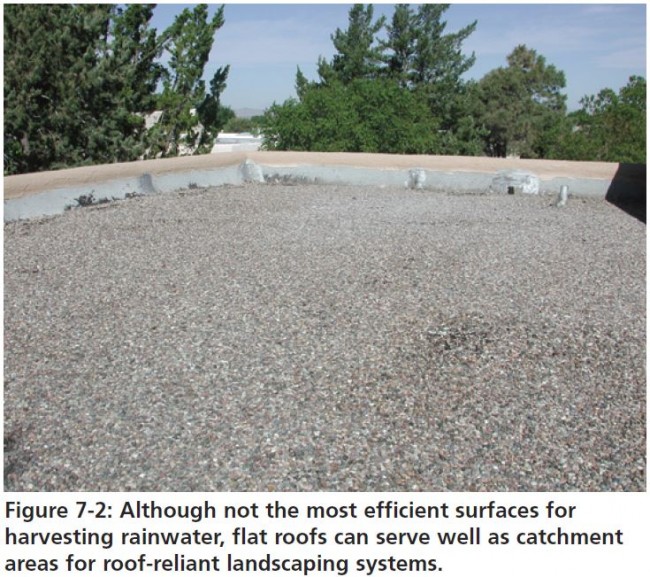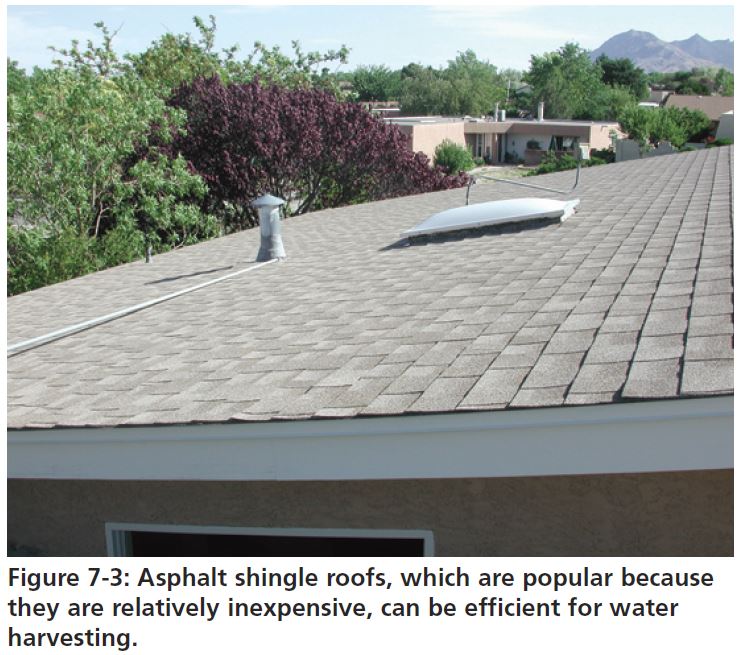The PermaDesign Weblog, with Nate Downey and Melissa McDonald!
Roof-Reliant Landscaping™ Step 15D: Water Collection - Roof Materials (Flat Roofs)
As discussed above, while so-called flat roofs are not the preferred type of roof from a water harvesting perspective, they are quite effective at harvesting water nonetheless. When the collected water is designated for nonpotable uses such as watering plant material, the drawbacks, in terms of both water quality and quantity, are relatively minor. If your roof happens to be flat, be assured that you can create a totally roof-reliant landscape with any of the flat roof materials commonly used in New Mexico. (See Figure 7-2.)
Asphalt. A wide variety of asphalt-based roofing materials is available for flat roofs, including tar and gravel, built-up roofs, cap sheet, torch down and roll roofing. The advantage of asphalt products is their relatively low cost. The downside of these materials is that the asphalt will slowly leach toxins into your cistern system. However, your plants will be able to tolerate these low levels of toxins without difficulty. (See Figure 7-3.)
Rubber. An increasingly popular kind of roof is made primarily out of a rubber product known as ethylene propylene diene monomer (EPDM). Seamless, long lasting, durable and less toxic than asphalt, EPDM is becoming more pricecompetitive. It has none of the strong odors associated with asphalt and is sometimes touted as a “green” roof since the rubber content can be made out of recycled materials.
Modified bitumen. This material is an asphaltbased product that contains a unifying agent, or modifier, that enhances the waterproofing characteristics of the asphalt. These modifiers include rubber, polyester, fiberglass and atactic polypropylene. If properly installed, such roofs should last longer than typical tar-and-gravel roofs, but they also require more skill to install than most flat asphalt surfaces.
Polyurethane. Another alternative is polyurethane foam, which leaches fewer toxins than many of its flat-roof counterparts, making it a good choice for water harvesting projects. Although it is more expensive than some of the other roof materials, polyurethane foam is an excellent insulator. Polyurethane must be covered with either a UV-resistant coating or, like many asphalt roofs, with gravel.
NOTE: The information presented in this blog is intended to be an overview of some of the most common roofing types and materials. Other roof materials may also provide suitable surfaces for catchment areas, and further advances in technology will no doubt result in additional choices. Some of the newest options—including PVC single sheet membrane and thermoplastic polyolefin (TPO) membrane—offer efficient catchment surfaces and low toxicity. When choosing a surface for a new roof, it is important to select a nontoxic or low-toxic material that provides a high runoff coefficient.
01/19/2016 | (2) Comments












Comments
Thank you for sharing valuable information related to roofing. This will be useful for industrial businesses. I will definitely share this with our technical team
Thank you so much for sharing this information. It is very useful information for Businesses.